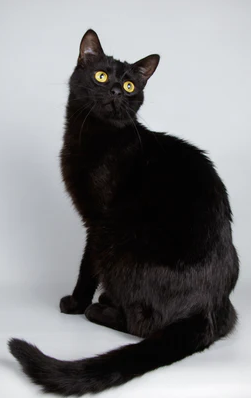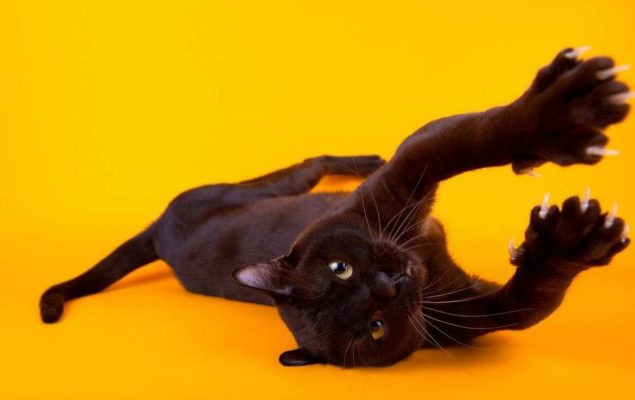Bombay Cat

Like the American Shorthair, the Bombay cat has a calm and balanced personality. The pet is friendly to everyone, never showing aggression. Bombays are contactable, affectionate, and sociable, just like their Burmese ancestors. They love all family members without exception.
Table of Contents
Breed Information
| Origin | United States |
| Size | 27-30 cm |
| Weight | Males 5-6 kg Females 3-4 kg |
| Fur Type | Short-haired |
| Color | Black |
| Lifestyle | Outdoors, indoors |
| Lifespan | 12-17 years |
| FIFe Classification | – |
| WCF Classification | Group 3: “Short-haired” Breed designation – BOM |
| TICA Classification | BO |
| Group | Short-haired cats, cats for kids |
| Price | $400-600 |
Breed Photos
Origin History
The Bombay cat first appeared in the United States in the 1950s. Breeder Niki Horner from Louisville set out to create a cat similar to the panther from Mowgli. The book’s action takes place in India, hence, most likely, the name of the breed. For 20 years, she had been breeding, crossing Burmese and American shorthair cats.
Up until the 70s, the breed was not recognized by influential organizations. In 1976, the Bombay cat was registered by the CFA. Three years later, TICA was recognized, but FIFe has not included Bombay even in the preliminary list.
Appearance
Representatives of the breed look similar to the Burmese; only the tail, paws, and body are slightly longer. The Bombay is a medium-sized cat with a well-proportioned, muscular body. Its chest is broad and well developed. The head is round; the muzzle is wide and slightly elongated. The pet’s jaws are powerful, and the bite is correct.
Medium-sized ears pointing forward rounded at the ends. The cat’s large, round eyes are wide apart. The color of the cat is allowed in shades from amber to gold. The limbs are muscular, medium length, and the paws are round. The tail of the cat is medium length, thick. The coat is short, thin, without an undercoat. Color coal-black, solid.
Character
Like the American Shorthair, the Bombay cat has a calm and balanced personality. The pet is friendly to everyone, never showing aggression. Bombays are contactable, affectionate, and sociable, just like their Burmese ancestors. They love all family members without exception.
Cats are inseparable from their owners, always accompanying them. They treat strangers well. The pet of this breed is agile and energetic. He gets along well with children, with pleasure, runs, and plays with them. If the cat does not like something, it will not show its teeth and leave.
Care
Bombay is a heat-loving pet. Therefore, he is not particularly interested in walking outside. But a new house for resting the pet will be very happy. Also, be sure to buy the cat litter box and change the litter in time.
Bombay’s short hair requires little care. Comb it a couple of times a week with a rubber brush or a glove. The cat should be bathed with a special shampoo. Because of secretions, it is worth washing the cat’s eyes every day. Do this with special products or at least tea brew.
Education
There will be no problem with raising an intelligent and intelligent cat. Early socialization is important in this matter. Introduce the kitten to the outside world as early as possible. Be sure to accustom him to the litter box and scratching post. Despite the fame of fierce house cats, Bombay likes to play and move around. Therefore, if desired, you can teach him simple commands and tricks.
The main thing is to organize the learning process playfully. It is important to encourage the cat with praise and tasty food. But yelling and negative emotions are unacceptable. A curious pet learns quickly so that everything will work out.
Common Diseases
In general, the cat is characterized by good health. But like other artificially bred breeds, Bombay is characterized by genetic diseases. These include:
- hypertrophic cardiomyopathy;
- skull defect;
- eye diseases;
- cystitis;
- gum disease.
The breed is also prone to colds. Avoid drafts and hypothermia. Pay special attention to the health of the cat’s eyes, ears, and teeth. Clean them in time. Once every six months, we recommend taking your pet to the veterinarian. Also, carry out routine vaccinations and dehelminthization. With proper care, a Bombay cat can live up to 20 years.
Nutrition
A pet’s excellent appetite can lead to obesity. Therefore, the question of nutrition should be approached responsibly. It is better to give preference to ready-made dry food. They contain all the necessary vitamins and minerals. Or feed the natural cat food, but do not combine them.
Bombay’s diet must consist of 80 percent protein. It is primarily lean meat and by-products. Milk and dairy products are also suitable. Not superfluous will be porridges, such as buckwheat, oatmeal, or wheat. Sometimes give your pet saltwater fish, but without bones. Feed the cat with vegetables and fruits to strengthen the body with nutrients.
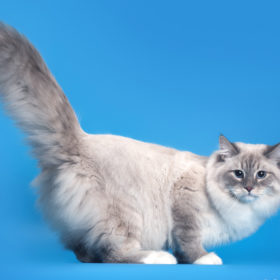 Neva Masquerade
Neva Masquerade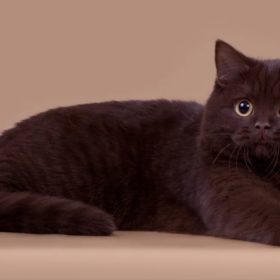 York Chocolate
York Chocolate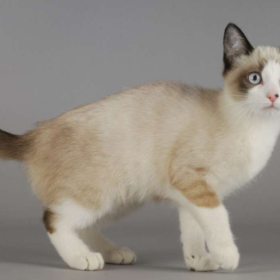 Snowshoe
Snowshoe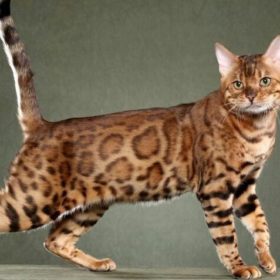 California Spangled
California Spangled Maine Coon
Maine Coon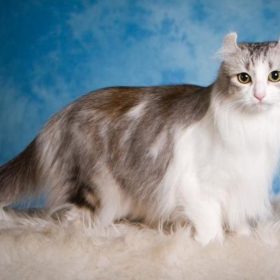 American Curl Longhair
American Curl Longhair
